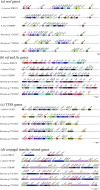Comparative genome analysis of Sesbania cannabina-nodulating Rhizobium spp. revealing the symbiotic and transferrable characteristics of symbiosis plasmids
- PMID: 37133904
- PMCID: PMC10272884
- DOI: 10.1099/mgen.0.001004
Comparative genome analysis of Sesbania cannabina-nodulating Rhizobium spp. revealing the symbiotic and transferrable characteristics of symbiosis plasmids
Abstract
Symbiotic nitrogen fixation between legumes and rhizobia makes a great contribution to the terrestrial ecosystem. The successful symbiosis between the partners mainly depends on the nod and nif genes in rhizobia, while the specific symbiosis is mainly determined by the structure of Nod factors and the corresponding secretion systems (type III secretion system; T3SS), etc. These symbiosis genes are usually located on symbiotic plasmids or a chromosomal symbiotic island, both could be transferred interspecies. In our previous studies, Sesbania cannabina-nodulating rhizobia across the world were classified into 16 species of four genera and all the strains, especially those of Rhizobium spp., harboured extraordinarily highly conserved symbiosis genes, suggesting that horizontal transfer of symbiosis genes might have happened among them. In order to learn the genomic basis of diversification of rhizobia under the selection of host specificity, we performed this study to compare the complete genome sequences of four Rhizobium strains associated with S. cannabina, YTUBH007, YTUZZ027, YTUHZ044 and YTUHZ045. Their complete genomes were sequenced and assembled at the replicon level. Each strain represents a different species according to the average nucleotide identity (ANI) values calculated using the whole-genome sequences; furthermore, except for YTUBH007, which was classified as Rhizobium binae, the remaining three strains were identified as new candidate species. A single symbiotic plasmid sized 345-402 kb containing complete nod, nif, fix, T3SS and conjugal transfer genes was detected in each strain. The high ANI and amino acid identity (AAI) values, as well as the close phylogenetic relationships among the entire symbiotic plasmid sequences, indicate that they have the same origin and the entire plasmid has been transferred among different Rhizobium species. These results indicate that S. cannabina stringently selects a certain symbiosis gene background of the rhizobia for nodulation, which might have forced the symbiosis genes to transfer from some introduced rhizobia to the related native or local-condition-adapted bacteria. The existence of almost complete conjugal transfer related elements, but not the gene virD, indicated that the self-transfer of the symbiotic plasmid in these rhizobial strains may be realized via a virD-independent pathway or through another unidentified gene. This study provides insight for the better understanding of high-frequency symbiotic plasmid transfer, host-specific nodulation and the host shift for rhizobia.
Keywords: Rhizobium; Sesbania cannabina; conjugal transfer; secretion system; symbiotic plasmid.
Conflict of interest statement
The authors declare that there are no conflicts of interest
Figures





Similar articles
-
Diverse Genomic Backgrounds Vs. Highly Conserved Symbiotic Genes in Sesbania-Nodulating Bacteria: Shaping of the Rhizobial Community by Host and Soil Properties.Microb Ecol. 2020 Jul;80(1):158-168. doi: 10.1007/s00248-020-01489-7. Epub 2020 Jan 29. Microb Ecol. 2020. PMID: 31996939
-
Genetic diversity and community structure of rhizobia nodulating Sesbania cannabina in saline-alkaline soils.Syst Appl Microbiol. 2016 May;39(3):195-202. doi: 10.1016/j.syapm.2016.02.004. Epub 2016 Mar 17. Syst Appl Microbiol. 2016. PMID: 27061259
-
Nodulation of Sesbania species by Rhizobium (Agrobacterium) strain IRBG74 and other rhizobia.Environ Microbiol. 2009 Oct;11(10):2510-25. doi: 10.1111/j.1462-2920.2009.01975.x. Epub 2009 Jun 25. Environ Microbiol. 2009. PMID: 19555380 Free PMC article.
-
Nodulation outer proteins: double-edged swords of symbiotic rhizobia.Biochem J. 2015 Sep 15;470(3):263-74. doi: 10.1042/BJ20150518. Biochem J. 2015. PMID: 26341483 Review.
-
Emergence of β-rhizobia as new root nodulating bacteria in legumes and current status of the legume-rhizobium host specificity dogma.World J Microbiol Biotechnol. 2020 Feb 24;36(3):40. doi: 10.1007/s11274-020-2811-x. World J Microbiol Biotechnol. 2020. PMID: 32095903 Review.
Cited by
-
Microvirga sesbaniae sp. nov. and Microvirga yunnanensis sp. nov., Pink-Pigmented Bacteria Isolated from Root Nodules of Sesbania cannabina (Retz.) Poir.Microorganisms. 2024 Jul 30;12(8):1558. doi: 10.3390/microorganisms12081558. Microorganisms. 2024. PMID: 39203400 Free PMC article.
-
Forage Crop Research in the Modern Age.Adv Sci (Weinh). 2025 Jul;12(27):e2415631. doi: 10.1002/advs.202415631. Epub 2025 Jun 30. Adv Sci (Weinh). 2025. PMID: 40586694 Free PMC article. Review.
References
Publication types
MeSH terms
LinkOut - more resources
Full Text Sources
Miscellaneous

